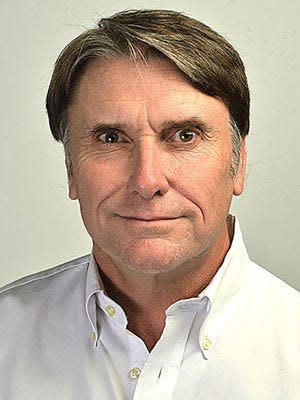Green energy is happening. It's a good thing we're focused on the culture wars
- Oops!Something went wrong.Please try again later.
- Oops!Something went wrong.Please try again later.
In 1979 Jimmy Carter famously had solar panels installed on the roof of the White House West Wing. Seven years later, Ronald Reagan not-so-famously had them taken down.
Carter’s goal was for America to draw 20% of its energy from solar power by 2000. Twenty-two years after the passing of that date, we’re only halfway there.
Had the world listened to Jimmy Carter, no one would be grousing about energy prices today, nor would Putin be in a position to hold an oily gun to the head of the world. No one would care what Saudi Arabia thought about anything.

But, of course, Carter was just this whacky guy who wore sweaters indoors and got himself attacked by rabbits. Even his fight for energy independence, which he called the Moral Equivalent of War, was ridiculed by those who noticed that the acronym added up to MEOW.
But 40 years after the fact, Carter’s vision is taking shape. President Joe Biden’s visit to the former Mack Trucks Hagerstown is reflective of the nooks and crannies into which the national energy retrofit will flow.
It was also about 40 years ago that Mack employees first heard the word “outsourcing,” a corporate euphemism for sending jobs elsewhere. Like the tide going out, thus began a great national industrial contraction that shuttered factories and mills, and idled a workforce that had been taught to expect a covenant with capital that rewarded loyal work with a comfortable place in the community for life.
More:President Biden lays out 'middle class' economic vision at Hagerstown Volvo factory
The shattering of this covenant by management, which sent jobs overseas in exchange for fatter profit margins, is largely responsible for the political upheaval we are seeing today. People have understandably become embittered by the loss of economic advantages that their parents and grandparents had. Lacking stability, they worship the false gods who egg on their anger.
Because of this, many see democracy as hanging by a thread, and maybe it is. But as the news shows focus on the cultural issues and the political divisions that guarantee viewers — and upwardly spiraling anger — more important stuff is happening on the ground.
When the mid-Atlantic was devastated by flooding in 1985, plenty of politicians demonstrated their concern by flying over the land in helicopters to “survey the damage.” But one 5-foot-tall West Virginia state senator famously strapped on her muck boots and began helping people shovel out their homes. As one political operative said at the time, “The mud is where the votes are.”
So while the political opportunists of today are screaming their dissatisfaction with everything, there is a movement to rebuild this country that’s happening down in the mud.
More:Why is the president coming to Hagerstown? Well, why not?
It is almost incomprehensible that two bills of such consequence — last year’s Bipartisan Infrastructure Bill and the summer’s green-energy-focused Inflation Reduction Act — have passed into law with so little comment.
We became so focused with process, winners and losers, and the melodrama of West Virginia Sen. Joe “Days of Our Lives” Manchin that once the bills passed into law, we forgot all about them.
But as Transportation Secretary Pete Buttigieg — perhaps the beneficiary of the most fortuitous job opening in the history of our nation’s government — crisscrosses the country delivering money, jobs and hope, the first blocks of a new foundation are being cemented into place.
Maybe results no longer matter in this new world of social-media driven cult politics. But the grinning GOP politicians who are showing up at ribbon-cuttings for projects they voted against would suggest otherwise. The votes are still in the mud.
War, speeches, golf and a car wreck:Presidential presences in Washington County
So too, in a couple of years, will we begin to see the full effects of an entire automobile industry being rebuilt, of green energy projects and massive new investments in batteries and computer chips.
Not all these projects will succeed, but such is the price of innovation. So much fuss was made over the failure of Solyndra that we seem not to have noticed that President Barack Obama’s technological spending also helped give rise to a little car company called Tesla.
Sometimes critical government mass is a disaster — witness ethanol, an evil genie that, thanks to special interests, we have been unable to cram back into the bottle. But when programs are good, this lack of a reverse gear becomes an asset.
In the course of the past year, America’s new industrial, energy and manufacturing ship has left the dock, and there will be no recalling it to port no matter which political party holds office. It is, in a sense, almost beneficial that we have kept a laser focus on the Supreme Court, inflation, immigration and the daily persecution of Donald Trump — these sideshows divert attention (and potential sabotage) away from stuff that really matters.
It’s taken 40-plus years, but we’ve finally come to understand one thing: Jimmy Carter was right.
Tim Rowland is a Herald-Mail columnist.
This article originally appeared on The Herald-Mail: While US focuses on other things, the green revolution takes hold
